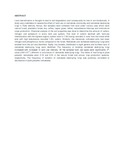Diversity of nematodes and nematode destroying fungi as influenced by land use in Taita Taveta, Kenya.

View/
Date
2013Author
Wachira, PM
Kimenju, JW
Okoth, SA
Kiarie, JW
Type
ArticleLanguage
enMetadata
Show full item recordAbstract
Land intensification is thought to lead to soil degradation and consequently to loss of soil biodiversity. A study was undertaken to assess the effect of land use on nematode community and nematode destroying fungi in Taita districts, Kenya. Soil samples were collected from land under various uses which were natural forest, plantation forest, tea, coffee, napier grass, fallow, maize/beans intercrop and horticultural crops production. Chemical analysis of the soil properties was done to determine the amount of carbon, nitrogen and potassium in every land use system. The level of carbon declined with land-use intensification with the highest organic carbon level of 7.6% being recorded in soils from the forest while land with high disturbance recorded 1.6% carbon. Similarly, the intensively cultivated soils had lower nitrogen and phosphorous levels compared to the forest. Nematode and nematode destroying fungi were isolated from the soil and identified. Eighty five isolates, distributed in eight genera and fourteen taxa of nematode destroying fungi were identified. The frequency of isolating nematode destroying fungi increased with increased in land use intensity. All the sampled land use types were significantly (P-value=3.81×10-07) different in occurrence of nematode destroying fungi. The ratios of free-living to plant parasitic nematodes were 5.18 and 0.54 in the natural forest and annual crop production systems, respectively. The frequency of isolation of nematode destroying fungi was positively correlated to abundance of plant parasitic nematodes.
URI
http://www.cabdirect.org/abstracts/20143008833.html?resultNumber=2&q=kimenju+j+2014http://hdl.handle.net/11295/66012
Citation
Journal of Agricultural Science (Toronto) 2013 Vol. 5 No. 12 pp. 154-161Publisher
University of Nairobi,
